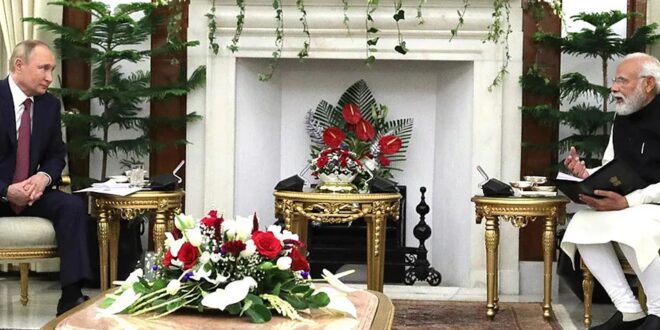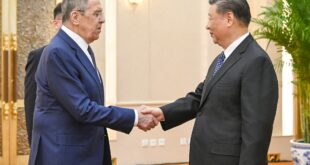Recent talks in New Delhi between the two countries’ leaders highlight the pragmatic nature of India’s dealings with Russia.
The significance of the official visit of Russian President Vladimir Putin, Foreign Minister Sergey Lavrov and Defence Minister Sergey Shoigu to New Delhi on 6 December should be seen in relation to India’s place in Russia’s global strategy – and Moscow’s praise for its Comprehensive Strategic Partner, China. India and its top strategic partner, the US, should pay attention to Putin’s assertion that it is ‘natural’ that China’s ‘military might grows along with the rise in the economic potential’, and that China’s growing might ‘first of all … relates to its economic might … why should we follow third countries’ interests in building our policy?’
Never mind the rhetoric about tried and tested friendship: realpolitik defines India–Russia bilateral relations. This was obvious when, laden with arms and investment deals, Russian officials sealed the sale of the S-400 Triumf to India. Delivery started last month. India and Russia also signed a 10-year pact for joint arms production.
Different Indian and Russian Priorities
Russia’s previous sale of the S-400 to China in 2015 reflected their shared aim of challenging the US’s Asian and global primacy.
India’s strategic priorities are its border conflicts with China and Pakistan and its immediate Indian Ocean neighbourhood.
India must contend with the Chinese iron in Russia’s fire. An economically and militarily strong China – which is also hostile to the US – with its $15 trillion economy and $252.3 billion defence spending can offer Russia more than US-friendly India with its $3 trillion economy and $72.9 billion military expenditure. China’s GDP per capita is $10,434.8, India’s $1,927.7 and Russia’s $10,126.7.
Ranking lower than China economically, and with its defence spending declining over the last five years, India cannot realistically be expected to drive a wedge between Moscow and Beijing.
India wants the S-400 to strengthen its defences against Chinese aggression. The US has not given India any comparable defence system. Apparently, New Delhi thinks it worthwhile to risk the imposition of sanctions under the Countering America’s Adversaries Through Sanctions Act (2017) and to buy the S-400. Lavrov applauded India’s refusal to ‘follow US orders’.
The complex reality is that India must square its dependence on Russia for most of its weapons with the aim of securing its territory against a hawkish ChinaSignificantly, Russia’s sale of the S-400 to Asia’s major rivals, India and China, is a diplomatic feat that enables Moscow to retain both as its largest customers and China as its main strategic partner. Russia needs both buyers to keep its defence industry functioning smoothly.
Additionally, cognisant of New Delhi’s wish to ‘Make in India’ and export arms, Russia has licensed production of state-of-the-art tanks, aircraft, rifles and supersonic missiles in India. The Brahmos missile, jointly manufactured by India and Russia, has already been sold to its first buyer, the Philippines. Such exports also serve Russia’s interests: they are part of Moscow’s current strategy to sell more arms to countries in Southeast Asia, with the intent of increasing its regional clout.
The complex reality is that India must square its dependence on Russia for most of its weapons with the aim of securing its territory against a hawkish China. Russian arms have equipped more than 60% of India’s defence forces over five decades. India’s foreign secretary, Harsh Vardhan Shringla, warns that without Russian spare parts and maintenance help, ‘our ships won’t sail, our planes won’t fly’.
However, ties with Russia have always been a double-edged sword. Moscow and Beijing oppose India’s support for Washington’s concept of the Indo-Pacific and its participation in the Quadrilateral Security Dialogue together with the US and its old allies, Japan and Australia. But India has distanced itself from the Australia–UK–US grouping (AUKUS).
In New Delhi, Lavrov aired Moscow’s dislike of US-sponsored concepts that India favours, and claimed that the Indian and Russian positions on the Indo-Pacific ‘coincide’. In their Joint Statement, India and Russia reaffirmed the need for a free, open, transparent and inclusive regional security architecture, based on universally recognised principles of international law. But the statement pointedly omitted the term ‘Indo-Pacific’ and referred to their efforts to build ‘equal and indivisible regional security … in the regions of Indian and Pacific oceans’.
Meanwhile, Russia’s silence on China’s expansionism in India and Southeast Asia does not suit India.
Significantly, like its partner, China, Russia harbours imperialist ambitions. India’s relationship with Russia was important enough for New Delhi to have been reticent about Russia’s invasions of Georgia (2008) and Ukraine (2014) and annexations of parts of their territories. And in November 2020, India voted against a Ukraine-sponsored resolution in the UN condemning Russia’s alleged human rights violations in Crimea. During Putin’s visit, Indian officials made no public reference to reports about Russia massing troops on its border with Ukraine and planning to invade the country.
Trade and investment ties also show India lagging behind China. Trade between Russia and China is expected to reach a record $130 billion in 2021. Last year, India–Russia trade amounted to just over $9 billion.
With China’s aggressiveness and Russia’s hands-off approach to the Sino-Indian territorial contest, India will remain keen to strengthen its military and economic ties with the USSince 2015, Chinese investment has accounted for 85% of foreign investment in the Russian Far East, an area comprising one-third of Russia and rich in minerals, hydrocarbons, timber and fish. India is a latecomer to the area. In 2020, China’s trade with the Russian-led Eurasian Union amounted to $126 billion, while India’s was $9 billion.
India’s Conundrum
US–India trade will exceed $100 billion this year. But the fact remains that strategically autonomous India is in the unenviable position of being dependent on Russian arms to safeguard its territorial sovereignty, while relying on the US military presence in Asia to keep China at bay in the Indo-Pacific.
With China’s aggressiveness and Russia’s hands-off approach to the Sino-Indian territorial contest, India will remain keen to strengthen its military and economic ties with the US.
India cannot afford to slip on the political ice and fall flat between two enemies – Russia and the US. Both are its friends. The US reaction to Putin’s deals with India is unclear. But given Moscow’s endorsement of the intertwining of China’s progress with its military ascent, New Delhi should not focus on creating a divide between Russia and China. Instead, realpolitik should compel it to remain on good terms with Russia – and the US.
The outstanding fact is that an economically and militarily strong China can advance Russia’s global interests more than India – or indeed any other country.
So, given the link between economics and strategy – as highlighted by Putin with reference to China – New Delhi should pursue policies that will strengthen India’s economic and military sinews, and polish its credentials as a major contributor to Asia’s development and security. This would add weight to India’s power play with Russia.
 Eurasia Press & News
Eurasia Press & News




